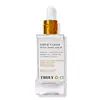What's inside
What's inside
 Key Ingredients
Key Ingredients

 Benefits
Benefits

 Concerns
Concerns

 Ingredients Side-by-side
Ingredients Side-by-side

Caprylic/Capric Triglyceride
MaskingParfum
MaskingSimmondsia Chinensis Seed Oil
EmollientVitis Vinifera Seed Oil
EmollientTocopheryl Acetate
AntioxidantPassiflora Incarnata Seed Oil
Skin ProtectingLavandula Angustifolia Oil
MaskingCocos Nucifera Oil
MaskingAdansonia Digitata Seed Oil
EmollientCarthamus Tinctorius Seed Oil
MaskingFragaria Vesca Fruit Extract
AstringentSodium Hyaluronate
HumectantVanilla Planifolia Fruit Oil
EmollientHydrolyzed Rice Protein
Skin ConditioningLinoleic Acid
CleansingLinolenic Acid
CleansingTocopherol
AntioxidantCitric Acid
BufferingSodium Benzoate
MaskingWater
Skin ConditioningBenzyl Benzoate
AntimicrobialPhenoxyethanol
PreservativeCI 26100
Cosmetic ColorantCaprylic/Capric Triglyceride, Parfum, Simmondsia Chinensis Seed Oil, Vitis Vinifera Seed Oil, Tocopheryl Acetate, Passiflora Incarnata Seed Oil, Lavandula Angustifolia Oil, Cocos Nucifera Oil, Adansonia Digitata Seed Oil, Carthamus Tinctorius Seed Oil, Fragaria Vesca Fruit Extract, Sodium Hyaluronate, Vanilla Planifolia Fruit Oil, Hydrolyzed Rice Protein, Linoleic Acid, Linolenic Acid, Tocopherol, Citric Acid, Sodium Benzoate, Water, Benzyl Benzoate, Phenoxyethanol, CI 26100
Ingredients Explained
These ingredients are found in both products.
Ingredients higher up in an ingredient list are typically present in a larger amount.
This ingredient is an emollient, solvent, and texture enhancer. It is considered a skin-softener by helping the skin prevent moisture loss.
It helps thicken a product's formula and makes it easier to spread by dissolving clumping compounds.
Caprylic Triglyceride is made by combining glycerin with coconut oil, forming a clear liquid.
While there is an assumption Caprylic Triglyceride can clog pores due to it being derived from coconut oil, there is no research supporting this.
Learn more about Caprylic/Capric TriglycerideParfum is a catch-all term for an ingredient or more that is used to give a scent to products.
Also called "fragrance", this ingredient can be a blend of hundreds of chemicals or plant oils. This means every product with "fragrance" or "parfum" in the ingredients list is a different mixture.
For instance, Habanolide is a proprietary trade name for a specific aroma chemical. When used as a fragrance ingredient in cosmetics, most aroma chemicals fall under the broad labeling category of “FRAGRANCE” or “PARFUM” according to EU and US regulations.
The term 'parfum' or 'fragrance' is not regulated in many countries. In many cases, it is up to the brand to define this term.
For instance, many brands choose to label themselves as "fragrance-free" because they are not using synthetic fragrances. However, their products may still contain ingredients such as essential oils that are considered a fragrance by INCI standards.
One example is Calendula flower extract. Calendula is an essential oil that still imparts a scent or 'fragrance'.
Depending on the blend, the ingredients in the mixture can cause allergies and sensitivities on the skin. Some ingredients that are known EU allergens include linalool and citronellol.
Parfum can also be used to mask or cover an unpleasant scent.
The bottom line is: not all fragrances/parfum/ingredients are created equally. If you are worried about fragrances, we recommend taking a closer look at an ingredient. And of course, we always recommend speaking with a professional.
Learn more about ParfumTocopherol (also known as Vitamin E) is a common antioxidant used to help protect the skin from free-radicals and strengthen the skin barrier. It's also fat soluble - this means our skin is great at absorbing it.
Vitamin E also helps keep your natural skin lipids healthy. Your lipid skin barrier naturally consists of lipids, ceramides, and fatty acids. Vitamin E offers extra protection for your skin’s lipid barrier, keeping your skin healthy and nourished.
Another benefit is a bit of UV protection. Vitamin E helps reduce the damage caused by UVB rays. (It should not replace your sunscreen). Combining it with Vitamin C can decrease sunburned cells and hyperpigmentation after UV exposure.
You might have noticed Vitamin E + C often paired together. This is because it is great at stabilizing Vitamin C. Using the two together helps increase the effectiveness of both ingredients.
There are often claims that Vitamin E can reduce/prevent scarring, but these claims haven't been confirmed by scientific research.
Learn more about Tocopherol